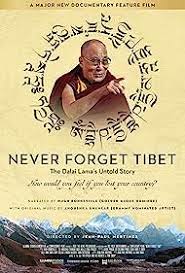
NEVER FORGET TIBET
UK, 2022, 94 minutes, Colour.
Narrated by Hugh Bonneville.
Directed by Jean-Paul Mertinez.
This is a very worthy project. It cannot be condemned by those who dislike straightforward narratives, chronicled from beginning to end. Rather, this documentary has a whole lot of themes, all mixed together, sometimes reappearing unexpectedly (and without immediate reason).
There are many reasons for watching the film. One of the main reasons is to go back to the Dalai Lama’s history, the complex relationship with the Chinese government in 1950 and then his escape from Lhasa in March 1958.
There is some initial background about the Dalai Lama himself, his being a reincarnation of previous Dalai Lamas, interviews with members of his family, especially with his younger brother, very articulate, remembering the past, the escape, his own life, studies, hippy days, serious days and study, as well as the Dalai Lama’s sister who reestablished the Buddhist nuns, fostering their training, academic education, contempt of life in exile in India.
The film introduces us to an Indian journalist, niece of the Indian official who guided and received the Dalai Lama and his entourage at the time of their escape. There is a sequence where he meets the Dalai Lama, embraces him, and they reminisce, as well as noting how each of them has got older. The journalist has been able to arrange time with the Dalai Lama.
Over the decades, the Dalai Lama has been an engaging personality, not always clear when speaking English, but always willing to do so, and there is his perennial humour and laugh. Here we have an opportunity to spend quite some time with the Dalai Lama, his comments about his experiences when young, his training, the episode with China in 1950, spending time in Beijing, interested in Marxism and Socialism, a relationship with Mao Tse Tung. However, he does spend quite a lot of time, giving quite some vivid detail of his memories of the escape, the timing, the dangers, the harsh Indian countryside and mountains, illness, the welcome when received.
There is also commentary by a younger Indian journalist focusing on the past but also highlighting aspect of Tibet in the present and the relationship with China.
And, scattered throughout the film are quite a number of episodes – an interview with a Buddhist leader and his explanation of meditation and chant; a meeting with the Dalai Lamas doctor; an interview with doctor who runs the medical centre today in Lhasa. And, throughout the film, there is an interview with an expert on the Austrian traveller, Heinrich Harrer, famous for his book (and the subsequent film with Brad Pitt) Seven Years in Tibet. His being in Tibet is explained, his time there, his understanding of the Buddhist culture, the role of the Dalai Lama. And, keeping records of his experiences in Tibet, also taking advantage, sometimes with very limited photographic equipment, of taking photos, preserving them through travels and difficulties, there are eventually being able to to be developed in 1951. The film incorporates many of these photos.
So, not the most polished of documentaries, but a great deal of interesting interviews, footage, photos, and the personality and the spiritual compassion and profound Buddhist messages as expressed by the Dalai Lama.